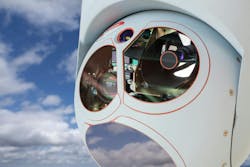Optical design software: From nano to system scale
Optical devices are used in increasingly complex applications today—ranging from data centers to autonomous vehicles. In many cases, desirable optical properties require manipulating light at wavelength scale. To integrate individual components and circuits into larger systems, designers must be able to work effectively at both nano and macro scales.
Nanoscale structures on the surface of light-emitting diodes (LEDs), for example, have been shown to enhance their efficiency. These photonic crystals have a refractive index that changes periodically on the scale of the wavelength of light. To model an array of these LEDs, a designer needs to be able to perform highly accurate simulations at the nanoscale while also being able to scale up to simulate many devices quickly and efficiently.
Design high-precision optical systems
In 2021, Ansys acquired Zemax, whose OpticStudio software is widely used to analyze, optimize, and tolerance high-precision optical systems. While OpticStudio is designed to model the interaction of light with structures that are much larger than the wavelength of light, Ansys offers a comprehensive platform to enable users to work at different scales—from nano to system level.
In addition to OpticStudio, this platform includes Ansys Lumerical, which is used to conduct highly accurate simulations of how light interacts with wavelength-scale structures by solving Maxwell’s equations, and Ansys Speos, which enables system-level visualization, validation, and rendering.
Speos can account for human visual acuity and perception as a part of its simulation capabilities, which is critical for applications such as automotive headlights and augmented reality (AR)/virtual reality (VR) headsets. This allows engineers to design optical systems with a full understanding of how they will be perceived by the human eye, which reduces the number of expensive physical prototypes that must be built before the system can be brought to market.
This platform is designed to take you from the nanoscale all the way up to the system level of design and modeling, and there is ongoing work to connect these solutions seamlessly through easy-to-use interfaces. Design engineers are empowered with the multiphysics, multiscale simulation needed to develop modern optical and optically enabled products.
Enabling photonic integrated circuits with optical design tools
Photonic integrated circuits (PICs) will transform the way we compute and transmit information. Compared to electronic circuits, PICs offer superior scalability and efficiency—but they are an emerging technology, and novel computational tools must be developed to reach their potential.
PICs will be critical for next-generation data centers. The rise of artificial intelligence (AI), 5G, and high-performance computing is creating rapidly increasing data requirements, which in turn requires exponentially increasing power. In today’s data centers, information is transferred between fiber-optic cables and electronic chips using copper interconnects. As bandwidth requirements increase, these copper links require too much energy and photonic/optical interconnects are the necessary solution to this problem.
Pluggable optics are available and viewed by many as the near-term answer to improving data center performance and reducing data center energy consumption. By integrating electronic and photonic components onto a single substrate, co-packaged optics (CPO) can increase bandwidth density and reduce power consumption. Ansys already has electronic and semiconductor tools in its portfolio, but is working to more tightly integrate these tools with photonic simulation solutions to enable engineers to efficiently and effectively design CPO-based systems.
System miniaturization and metalenses
Traditional lenses offer excellent functionality and image quality over a range of wavelengths. But because the curvature of the lens determines how light is bent by the lens, designers who want to miniaturize optical devices find themselves limited by traditional materials. This has led to increasing interest in metalenses or metasurfaces, which are nanopatterned surfaces that can be used to manipulate light.
These flat, thin devices can combine the functionality of several lenses into a single surface. It’s an area of research and development, but one in which more companies are showing interest. One example is Lumotive, a startup developing a liquid-crystal metasurface to steer light beams for remote sensing (LiDAR) for consumer, industrial, and automotive applications.
Improving efficiency and user experience
As well as developing toolkits for emerging materials and devices, the developers of optical design software are leveraging new technology to make their software faster and more user-friendly.
This approach is pioneered by Ansys, which offers high-performance capabilities using graphics processing units (GPUs) and cloud-based clusters. For example, last year Ansys showed that running their optical simulation software on a GPU can reduce the simulation time by as much as 60x compared to running on a standard laptop central processing unit (CPU).
Bringing optical simulation closer to real life
Idealized models often fail to capture the behavior of real-world optical components. If devices are manufactured in volume, it is vital to understand how variations in the fabrication can affect their performance. Ansys focuses on design for manufacture so users can include real-world effects in their simulations.
The company recently released a “composite surface” feature that captures the bumps and imperfections on the surface of a lens, which helps designers understand how sensitive their devices are to changes in shape.
Beyond this, the performance of optical devices often depends on external forces, vibrations, and changes in temperature. Ansys Mechanical can model how external structural and thermal loads modify both the shape of and temperature within optical components. These effects can then be incorporated into OpticStudio through the STAR capabilities of that software tool. Such a workflow can be used to explore phenomena such as the effects of changes in gravity on the optical components of a satellite.
Future of optical design
By listening to feedback from customers, developers can drive innovation by predicting the next set of capabilities that will benefit their users. When you’re in the software industry, you need to be open to the idea of doing something unique or different—things that the industry hasn’t thought about already, but will help meet their needs in producing the next generation of optical products.

Sanjay Gangadhara
Sanjay Gangadhara is the Senior Program Director for Optics at Ansys. In this role, he works closely with the leadership teams from Product Management and R&D to define the long-term product vision and business strategy for the Ansys Optics portfolio. As a part of this effort, Sanjay leads strategic partnership and business development activities within Ansys Optics and serves as a brand ambassador for the Optics portfolio. His background in general physics, electromagnetism, and optical systems diagnostics has served him well in his various roles throughout his career. Sanjay holds a Bachelor’s degree in Chemical Engineering & Nuclear Engineering from UC Berkeley and a Ph.D. in Nuclear Science & Engineering from MIT.

